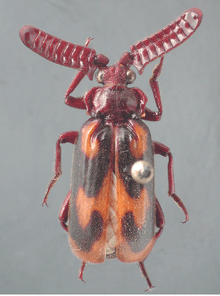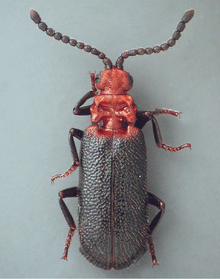Ant nest beetle
Ant nest beetles (subfamily Paussinae) or paussines, some members of which are known also as flanged bombardier beetles, are a large subfamily within the ground beetles (Carabidae). The tribes Metriini, Ozaenini, Paussini and Protopaussini are included in the subfamily.
| Ant nest beetles | |
|---|---|
.jpg) | |
| Cerapterus pilipennis (Paussini : Cerapterina) | |
| Scientific classification | |
| Kingdom: | |
| Phylum: | |
| Class: | |
| Order: | |
| Suborder: | |
| Superfamily: | Caraboidea |
| Family: | |
| Subfamily: | Paussinae Latreille, 1807 |
| Tribes | |
|
Metriini LeConte, 1853 | |
Rarely seen, most Paussinae are obligate or facultative myrmecophiles, living within the nests of ants, predatory on ant larvae and workers. Many have elaborate antennal structures and body parts flattened. Paussines are moderate sized (6–20 mm), characterised by glandular hairs that produce secretions attractive to ants and by the odd antennal structures of many species. Their pygidial glands can produce explosive secretions, giving them the other name of flanged bombardier beetles although they are not particularly close relatives of the typical bombardier beetles (Brachininae).
Biology
Very little is known about the immature stages of ant nest beetles. Most appear to live in ant nests in their early stages of life. Although many are facultative or obligate myrmecophiles, most do not appear like ants (i.e. myrmecomorphic) and unlike in the case of myrmecophilous larval Lycaenidae, there appears to be no benefit gained by the ants in this association.[1] Many species follow the trails of worker ants of specific species. Glandular secretions on their antennae and body allow them to interact with ant workers.[2] It is believed that the beetles use an acoustic mechanism to successfully imitate the sounds of an ant queen thus permitting them access to the nest without alarming the ants.[3] The defensive bombardier behaviour is never used against ants. Males of some species are attracted to lights during some parts of the season and are thought to disperse from one ant nest to another. Males are thought to be short-lived. These beetles feed on ant eggs, larvae and adults by piercing their mandibles into the abdomen or other soft part and sucking the contents. Apart from chemical mimicry and communication with their hosts, they also make use of vibrations. Several stridulatory structures are found in these beetles including alary-elytral, abdomen-femur and thorax-femur combinations of surfaces.[4]
Systematics
The subfamily Paussinae contains 49 genera, with around 800 species divided into the following tribes and subtribes:[5]
While some tribes like Metriini and Ozaenini appear quite similar to typical carabids, others have modified antennae and body shapes. The Protopaussini and Paussini are slender or compact in body shape with enlarged antennae in the Paussini.


Tribe Metriini
- Metrius Eschscholtz, 1829
- Sinometrius Wrase & Schmidt, 2006
Tribe Ozaenini
- Anentmetus Andrewes, 1924
- Crepidozaena Deuve, 2001
- Dhanya Andrewes, 1919
- Entomoantyx Ball & McCleve, 1990
- Eustra Schmidt-Goebel, 1846
- Filicerozaena Deuve, 2001
- Gibbozaena Deuve, 2001
- Goniotropis Gray, 1831
- Inflatozaena Deuve, 2001
- Itamus Schmidt-Goebel, 1846
- Microzaena Fairmaire, 1901
- Mimozaena Deuve, 2001
- Mystropomus Chaudoir, 1848
- Ozaena Olivier, 1812
- Pachyteles Perty, 1830
- Physea Brulle, 1834
- Physeomorpha Ogueta, 1963
- Platycerozaena Banninger, 1927
- Proozaena Deuve, 2001
- Pseudozaena Laporte de Castelnau, 1834
- Serratozaena Deuve, 2001
- Sphaerostylus Chaudoir, 1848
- Tachypeles Deuve, 2001
Tribe Paussini
Subtribe Carabidomemnina Wasmann, 1928
- Carabidomemnus H. Kolbe, 1924
- Eohomopterus Wasmann, 1919
Subtribe Cerapterina Billberg, 1820
- Arthropterus MacLeay, 1838
- Cerapterus Swederus, 1788
- Megalopaussus Lea, 1906
- Mesarthropterus Wasmann, 1926
Subtribe Heteropaussina Janssens, 1953
- Heteropaussus Thomson, 1860
Subtribe Homopterina Janssens, 1953
- Homopterus Westwood, 1838
Subtribe Paussina Latreille, 1807
- Ceratoderus Westwood 1841
- Eopaussus Wasmann, 1926
- Euplatyrhopalus Desneux, 1905
- Granulopaussus H. Kolbe, 1938
- Hylopaussus Luna de Carvalho, 1989
- Hylotorus Dalman, 1823
- Lebioderus Westwood, 1838
- Leleupaussus Luna de Carvalho, 1962
- Melanospilus Westwood, 1845
- Paussomorphus Raffray, 1885
- Paussus Linnaeus, 1775
- Platyrhopalopsis Desneux, 1905
- Platyrhopalus Westwood, 1838
- Pterorhopalus Maruyama, 2011
Subtribe Pentaplatarthrina Jeannel, 1946
- Hexaplatarthus Jeannel, 1955
- Pentaplatarthus Westwood, 1833
Tribe Protopaussini
- Protopaussus Gestro, 1892
References
- Moore, W; Xiao-bin Song; Andrea Di Giulio (2011). "The larva of Eustra (Coleoptera, Paussinae, Ozaenini):a facultative associate of ants". ZooKeys. 90: 63–82. doi:10.3897/zookeys.90.1136. PMC 3084492. PMID 21594107.
- Cammaerts, R; C Detrain; M-C Cammaerts. "Host trail following by the myrmecophilous beetle Edaphopaussus favieri (Fairmaire) (Carabidae, Paussinae)" (PDF). Cite journal requires
|journal=(help) - Andrea Di Giulio; Emanuela Maurizi; Francesca Barbero; Marco Sala; Simone Fattorini; Emilio Balletto; Simona Bonelli. "The Pied Piper: A Parasitic Beetle's Melodies Modulate Ant Behaviours". PLOS ONE. 10: e0130541. doi:10.1371/journal.pone.0130541. PMC 4496082. PMID 26154266.
- Geiselhardt, Stefanie F.; Klaus Peschke; Peter Nagel (2007). "A review of myrmecophily in ant nest beetles (Coleoptera: Carabidae: Paussinae): linking early observations with recent findings". Naturwissenschaften. 94: 871–894. doi:10.1007/s00114-007-0271-x. PMID 17563864.
- "Paussinae Latreille, 1807". Carabidae of the World. 2011. Retrieved 21 Jul 2011.
| Wikimedia Commons has media related to Paussinae. |